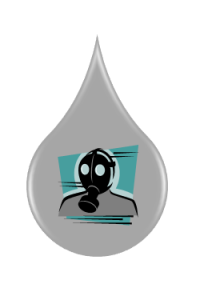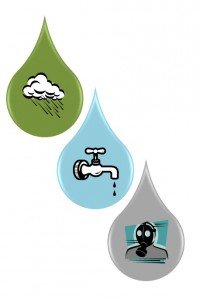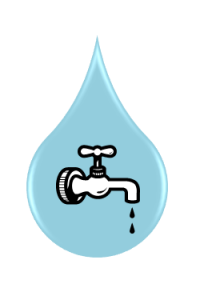You’ll likely suppose it is arrogant of me to use “The Compassionate Mormon” as the title of this series on water.[ref]Because this is written to a Mormon audience, I use “Mormon” terms and references that would resonate with that audience. However the basic principles in this post apply to all peoples.[/ref] We usually think of compassion in terms of taking meals to the sick or bearing the burdens of those who mourn.
The definition of compassion is:
n. a feeling of deep sympathy and sorrow for another who is stricken by misfortune, accompanied by a strong desire to alleviate the associated suffering
I argue that tens of millions of my brothers and sisters die every year due to issues related to lack of adequate water. I have a strong desire to do what is in my power to alleviate the pain and suffering those premature deaths cause.
Life in this world should be a joyful adventure in a land of peace and plenty, not a destitute hell of want. We must understand how water is consumed before we can hope to understand why water will be a limiting resource that causes war, death, and hunger.
The Well of Water: Blue Water
When I ask people how much water they think they use, most people think only in terms of the amount of water they drink. Occasionally they will also remember that they need water to wash dishes or flush toilets.
If they are the homeowner in their family, they will also likely realize that any water they use to water their landscaping “counts.” They may even remember the number of gallons their water bill says they used that month.
The rare person may also know that crops are often irrigated in our day, so when we eat those crops, or eat animals fed on those crops, or use fuel created from those crops, we should also count the water used to irrigate those crops.
Traditional thinking in the United States maintains that 70% of water withdrawn from freshwater sources (lakes, rivers, wells, aquifers) goes to agricultural uses, 20% goes to industry, and 10% goes to municipal use.[ref]From the Agricultural Water Clearing House FAQ, available online at http://www.agwaterconservation.colostate.edu/FAQs_WaterSupplySourcesAgriculturalUse.aspx, retrieved 26 Feb 2014.[/ref] In desert areas like Utah, as much as 60% of that municipal water goes to irrigating landscaping.[ref]From the Utah.gov Division of Water Resources, available online at http://www.conservewater.utah.gov/WhyConserve/, retrieved 26 Feb 2014.[/ref] So golf courses in the desert, for example, account for some fraction of the 6% of the total blue water used to support human activities.
Because most of us in the Western world can simply turn on a tap and get as much clean water as we need, we forget this resource is limited. We’re a bit like the young person who pays using a credit card, not understanding that you can’t reasonably spend more than is earned, at least not for long.
If we sustainably use our blue water resource, then the level of water in our aquifers will stay level from year to year. It’s like a family who spends no more than the amount of money they earn from year to year. However there are many aquifers in the world where the water table is dropping quickly, particularly arid “breadbaskets”.[ref]David Biello, Farmers Deplete Fossil Water In World’s Breadbaskets, available online at http://blogs.scientificamerican.com/observations/2012/08/09/farmers-deplete-fossil-water-in-worlds-breadbaskets/, retrieved 26 Feb 2014[/ref] Overpumping in the North China Plain, which produces half China’s wheat and a third of its corn, has largely depleted the shallow aquifer, forcing well drillers to turn to the region’s deep fossil aquifer, which is not replenishable.[ref]Lester Brown, Aquifer Depletion, available online at http://www.eoearth.org/view/article/150159/, retrieved 26 Feb 2014.[/ref]
In summary, we are spending our blue water resource faster than God (or rain, if you will) can refill it. And most of that blue water resource is being used to grow food.
The Windows of Heaven: Green Water
Almost everyone understands that rain provides water for crops. With accurate meteorological data, it is possible to determine how much rain falls throughout the world. We know how much of that rain ends up in rivers and streams and aquifers, and so we can also determine how much of that rain simply goes to keeping the ground moist.
When we try to figure out how much water is required to produce a crop (or keep a yard or golf course green), we need to factor in this “Green Water” if we are to be complete.[ref]See definition for Green Water in the Water Footprint Glossary, available online at http://www.waterfootprint.org/?page=files/Glossary, retrieved 26 Feb 2014.[/ref]
Green Water is like the manna the Hebrews received during the years they wandered between Egypt and Israel.[ref]Exodus 16[/ref] This rain water is vital to life, but cannot be stored. This water that remains in or on the soil will eventually evaporate. If that soil is planted, the water can evaporate to good purpose by evaporating out via the small holes in leaves that draw water and nutrients into a plant.[ref]See Transpiration, available online at http://en.wikipedia.org/wiki/Transpiration, retrieved 26 Feb 2014.[/ref]
The amount of Green Water required by a crop is closely linked to the amount of acreage required to grow that crop in a given climate.
One reason we need to understand Green Water is to prepare for the impact when we don’t get as much rain as we are expecting. This can occur due to natural variations in the weather or because of climate changes. The climate changes projected by the scientific community include arid regions becoming even more dry and humid climates experiencing volatile weather patterns of alternating drought and intense rainfall.
It takes a certain amount of water to produce our daily bread, if you will. Understanding how to assess the impact of future shifts in Green Water will help us maintain the ability to continue enjoying that life-giving “daily bread.”
The Fountain of Filthy Water: Gray Water

Gray Water, in the Water Footprint context, is the pure water required to dilute pollutants to clean water standards
In the movie, Erin Brokovich, actress Julia Roberts watches a female lawyer raise a glass of water to her lips. Julia comments:
By the way, we had that water brought in specially for you folks. Came from a well in Hinkley.
The real Erin Brokovich helped the residents of Hinkley win a $333 million settlement from Pacific Gas & Electric (PG&E) for contaminating their ground water with hexavalent chromium, a potent carcinogen. In the movie, the female lawyer refuses to drink the water, once she knew it came from the town PG&E claimed wasn’t being harmed.
The peak levels of hexavalent chomium in Hinkley came in at 20 parts-per-billion. The proposed safe level or “health goal” for that chemical is 0.02 parts per billion.[ref]Wikipedia article on Hinkley Groundwater Contamination, available online at http://en.wikipedia.org/wiki/Hinkley_groundwater_contamination, retrieved 26 Feb 2014.[/ref] So a cup of water from a Hinkley well would have to be diluted by 1000 cups of pure water to be rendered safe.
In similar fashion, human use of fresh water often includes adding something that pollutes the water. Run-off from human water use may contain pesticides, herbicides, oil, salts, detergents, medicinal chemicals like those used for birth control, and fecal matter. This is runoff you’d want to dilute with plenty of pure water before you’d consider drinking the resultant fluid.
Our industrial background teaches us that crop production can be increased by adding enough artificial fertilizer and protecting the desired crop with enough pesticide and herbicide. Even without pesticides and herbicides, fertilizer leaches nutrients like nitrate and phosphorus into local waters. When this happens, local waters can become “eutrophied.” If you know Greek, that sounds like a good thing, since it means “well nourished.” But when there is too much nutrient in waters, algae populations bloom, removing oxygen from the water and killing fish and other wildlife.
Nitrate (N) and Phosphorus (P) are a particular problem because of industrial practices. Less than a hundred years ago German chemist Fritz Haber invented a way to artificially produce ammonia, which is then transformed into nitrate to fertilize plants.[ref]See Nobel Prizes and Laureates: Frtiz Haber, available online at http://www.nobelprize.org/nobel_prizes/chemistry/laureates/1918/haber-bio.html, retrieved 26 Feb 2014.[/ref] At the time, Haber’s invention was praised as a significant mechanism by which Malthus’ predicted population implosion could be averted.[ref]See Malthusian Catastrophe, available online at http://en.wikipedia.org/wiki/Malthusian_catastrophe, retrieved 26 Feb 2014.[/ref] In our day, however, the amount of “bioavailable” N has double, and bioavailable P has tripled.[ref]Liu et al., Past and future trends in grey water footprints of anthropogenic nitrogen and phosphorus inputs to major world rivers, available online at http://www.waterfootprint.org/Reports/Liu-et-al-2012.pdf, retrieved 26 Feb 2014.[/ref] Use of artificial fertilizers is increasing the “load” of all waters to the point where we can’t dilute water back to clean levels that support life.
None of this is a problem if we don’t care about fish, manatees, or people.[ref]And all the other living beings damaged by polluted waters. I mention manatees because eutrophication of Florida’s waters from fertilizer runoff has cause the deaths of over a hundred manatees recently.[/ref] We may insist we don’t really care, and continue to consume foods that require waters be polluted to produce the food for the price and in the quantities we desire. But would we be willing to drink the water from those communities? If we would hesitate, how can we call ourselves compassionate while our actions condemn others to conditions we wouldn’t endure?
Water Footprint
When we discuss the total amount of water required by a product, then, we are talking about the water we withdraw from bodies of water, the amount of land/rainfall dedicated to production of that product, and the amount of water pollution that product causes.
Spencer W. Kimball said:
“I said again: ‘I seem to find no place in holy writ where God has said, “I give you title to this land unconditionally. It is now yours to give, to have, to hold, to sell, despoil, exploit as you see fit.”
“‘I cannot find such scripture, but I do find this from Psalms: “… those that wait upon the Lord, … shall inherit the earth.”’ (Ps. 37:9.)[ref]Doctrine and Covenants Student Manual, Section 104 The Order of the Church for the Benefit of the Poor, available online at https://www.lds.org/manual/doctrine-and-covenants-student-manual/section-101-109/section-104-the-order-of-the-church-for-the-benefit-of-the-poor?lang=eng, retrieved 26 Feb 2014.[/ref]
Armchair scriptorians may object, saying “God says the earth is full and there is enough for all to share.” I would urge such to read the entire passage:
For the earth is full, and there is enough and to spare; yea, I prepared all things, and have given unto the children of men to be agents unto themselves.
Therefore, if any man shall take of the abundance which I have made, and impart not his portion, according to the law of my gospel, unto the poor and the needy, he shall, with the wicked, lift up his eyes in hell, being in torment.[ref]D&C 104: 17-18[/ref]
There can be enough for all to share. But we’d better start actually sharing and paying attention to the amount of this earth’s resources we are taking from the common pool.





New Post: The Compassionate Mormon: Water 101: You’ll likely suppose it is arrogant of me to use … http://t.co/cHtpPLPpwF #LDS #Mormon
TheMillennialStar: The Compassionate Mormon: Water 101 http://t.co/RpnzMjQfIs #lds #mormon
What fraction of green water is snow pack? I’m curious since I live in a region with an aquifer and surrounding mountain ranges. Each winter the snowpack is measured as a percentage of “normal”. It was stated that like manna, green water cannot be stored. However with consistently cooler temps at high altitude a healthy snow pack can persist into mid summer. Where would that be factored in? (BTW interesting post)
I really like your other piece on hydroponics, as well as this one. I live in the gulf south where land loss, coupled with salt water intrusion, are wreaking havoc. I don’t have an easy fix to the water issues you raise except to help people be aware of the problem, which you are doing. It’s tough to conserve water and other resources in the world today. My guess is that until we (collectively) are pushed against the wall, we won’t make real strides towards dealing with the issues. Hopefully it won’t come too late.
Your “grey water” section reminded me of the commercials for bottled water. The commercials want to make it seem like mountain streams are the pinnacle of clean water. I wonder to myself what animals had peed upstream.
If can be hard to live with only your own rainwater supply, as most municipalities have made it illegal to collect rainwater runoff on your property. There was even a recent court case where someone in Florida was required to connect to the municipal water services, even if she never used any of them.
For irrigation needs, in desert places like Utah, what can be grown here without irrigation?
To Justin’s question, I think snow pack that subsequently melts and feeds mountain streams would be considered blue water. That gets factored in when the scientists consider the water flows across the year.
IDIAT, the science behind water is maturing because it is already causing death and wars–just not in North America. Because of the complexity of the markets, and the separation between modern people and food production, people don’t even realize the “cost” of their food in terms of water, land, and pollution. I had a guy earlier this week who maintained that it couldn’t possibly take more than a couple of gallons a day to grow his daily food.
Frank, the rushing mountain streams are an image of “good water” in our collective psyche. Rushing mountain waters are unlikely to have large deposits of waste from fodder animals, and tend not to be sufficiently contaminated with giardia to make one sick. Not that your average person even knows why a rushing mountain stream is supposedly “safe” to drink. But our ancestors would have known. Even someone like me remembers the manky orange-colored water you use to get from wells that supplied rest areas in the mid-west in the latter half of the 1900s. A mountain stream, no matter how many muskrat or deer might have “cleansed” themselves therein, would be far more appealing.
I’m curious Meg if you feel that the solution to this pressing issue is capitalism, as your libertarian co-authors would argue. Will the market fix this problem by itself? Will there be enough compassionate capitalists that they will sacrifice their self interest for the good of future humanity?
Or political solution needed? Does compassion need to be mobilized into political action which presses for legislation which regulates consumer and business misuse of water resources?
Hi Nate,
Consumers need to change their consumption habits. Consumers are like melon seeds – if you put external pressure on them, they’re liable to go shooting off in an opposite direction.
So I think education supported by policy is a good way to go. But government/political stuff will fail abjectly unless the individual consumers agree.
“education supported by policy is a good way to go”
And who does the education?
I favor a grass roots approach, personally. Non-profits, community groups of concerned citizens.
We already have the United Nations on this one pushing from the standpoint of the good of the world. The media has picked it up, with the proviso that they are hampered by the fact that the information coming from the UN and the Water Footprint Network (formerly an arm of UNESCO) is not yet crowd friendly and all in metric.
Darn it Meg, I keep trying to get you in trouble, and you are just too slippery:) Have you considered the example of California, which has been able to completely transform the water behavior of it’s citizens from time to time, but through entirely governmental means?
Inevitably, once the grass roots folks pick this up and start running with it, someone will also decide that it’d be a great thing if the government enforced good behavior. But that’ll be someone else’s windmill.
For me, in the here and now, I’m just trying to make this sufficiently clear that it’s hard to disagree with the conclusion by means of fatuous argument.
Actually, California’s change is not *entirely* through governmental means. There are literally hundreds of non-profits and voluntary groups that have worked to change how Californians use water. In fact, when the government has gotten involved we get the destruction of Mono Lake and cotton growing in the desert near Bakersfield. Meanwhile, government is literally starting hundreds of thousands of farmers in the Fresno area to save a small fish. Government has done much more harm than good in California. Meg is correct to emphasize grass roots, non-profit and voluntary efforts, which are more likely to work and less likely to do damage.